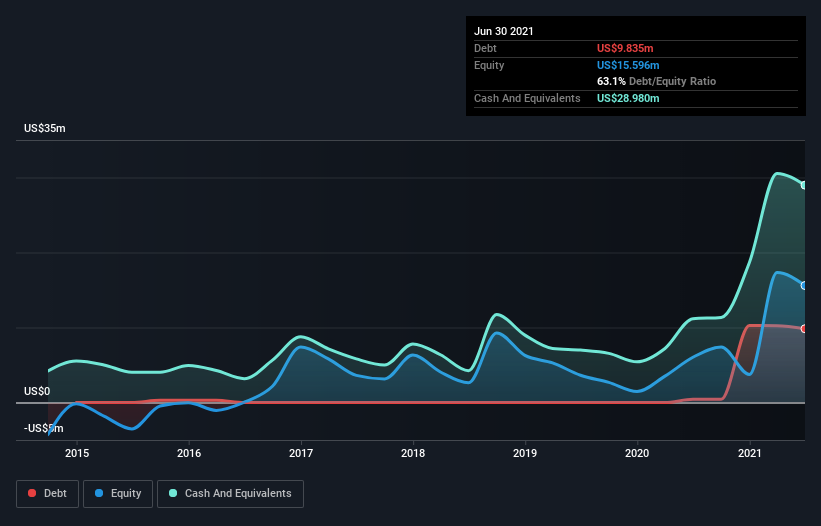Is Soligenix (NASDAQ:SNGX) Using Too Much Debt?
Howard Marks put it nicely when he said that, rather than worrying about share price volatility, 'The possibility of permanent loss is the risk I worry about... and every practical investor I know worries about.' So it seems the smart money knows that debt - which is usually involved in bankruptcies - is a very important factor, when you assess how risky a company is. We can see that Soligenix, Inc. (NASDAQ:SNGX) does use debt in its business. But the real question is whether this debt is making the company risky.
What Risk Does Debt Bring?
Debt and other liabilities become risky for a business when it cannot easily fulfill those obligations, either with free cash flow or by raising capital at an attractive price. In the worst case scenario, a company can go bankrupt if it cannot pay its creditors. However, a more frequent (but still costly) occurrence is where a company must issue shares at bargain-basement prices, permanently diluting shareholders, just to shore up its balance sheet. Of course, the upside of debt is that it often represents cheap capital, especially when it replaces dilution in a company with the ability to reinvest at high rates of return. The first thing to do when considering how much debt a business uses is to look at its cash and debt together.
View our latest analysis for Soligenix
What Is Soligenix's Debt?
As you can see below, at the end of June 2021, Soligenix had US$9.84m of debt, up from US$417.8k a year ago. Click the image for more detail. However, it does have US$29.0m in cash offsetting this, leading to net cash of US$19.1m.
A Look At Soligenix's Liabilities
The latest balance sheet data shows that Soligenix had liabilities of US$4.12m due within a year, and liabilities of US$9.89m falling due after that. On the other hand, it had cash of US$29.0m and US$224.3k worth of receivables due within a year. So it can boast US$15.2m more liquid assets than total liabilities.
This luscious liquidity implies that Soligenix's balance sheet is sturdy like a giant sequoia tree. With this in mind one could posit that its balance sheet means the company is able to handle some adversity. Simply put, the fact that Soligenix has more cash than debt is arguably a good indication that it can manage its debt safely. There's no doubt that we learn most about debt from the balance sheet. But it is future earnings, more than anything, that will determine Soligenix's ability to maintain a healthy balance sheet going forward. So if you want to see what the professionals think, you might find this free report on analyst profit forecasts to be interesting.
Over 12 months, Soligenix made a loss at the EBIT level, and saw its revenue drop to US$1.3m, which is a fall of 62%. To be frank that doesn't bode well.
So How Risky Is Soligenix?
We have no doubt that loss making companies are, in general, riskier than profitable ones. And in the last year Soligenix had an earnings before interest and tax (EBIT) loss, truth be told. Indeed, in that time it burnt through US$13m of cash and made a loss of US$12m. With only US$19.1m on the balance sheet, it would appear that its going to need to raise capital again soon. Overall, its balance sheet doesn't seem overly risky, at the moment, but we're always cautious until we see the positive free cash flow. When analysing debt levels, the balance sheet is the obvious place to start. But ultimately, every company can contain risks that exist outside of the balance sheet. For example, we've discovered 4 warning signs for Soligenix that you should be aware of before investing here.
Of course, if you're the type of investor who prefers buying stocks without the burden of debt, then don't hesitate to discover our exclusive list of net cash growth stocks, today.
This article by Simply Wall St is general in nature. We provide commentary based on historical data and analyst forecasts only using an unbiased methodology and our articles are not intended to be financial advice. It does not constitute a recommendation to buy or sell any stock, and does not take account of your objectives, or your financial situation. We aim to bring you long-term focused analysis driven by fundamental data. Note that our analysis may not factor in the latest price-sensitive company announcements or qualitative material. Simply Wall St has no position in any stocks mentioned.
Have feedback on this article? Concerned about the content? Get in touch with us directly. Alternatively, email editorial-team (at) simplywallst.com.

 Yahoo Finance
Yahoo Finance 
